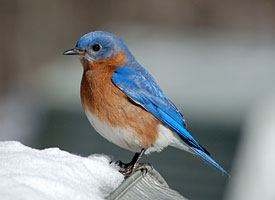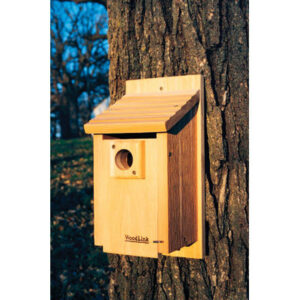If helping to build the Bluebird population is one of your goals as a birdwatcher, use this simple guide on how to start a Bluebird Trail to help these enchanting birds thrive.
11 steps to starting a Bluebird Trail in your neighborhood:
1. Understand the time and resources needed
Take the time to create a plan, budget and helper list. Bluebird Trails must be monitored, cleaned and maintained or the
nesting boxes will be exposed to predators and could even be taken over by House Sparrows, which threaten the Bluebird population.
Plan to spend at least three hours each week monitoring the birdhouses. Keep in mind, the monitoring can be done by a group of volunteers. One person doesn’t need to do all the work!
2. Research Bluebirds
 A number of good books have been written about helping to increase the Bluebird population. The Bluebird Monitor’s Guide or Bluebirding Basics are both great guides to get the amature trail leader started.
A number of good books have been written about helping to increase the Bluebird population. The Bluebird Monitor’s Guide or Bluebirding Basics are both great guides to get the amature trail leader started.
Knowing what to expect will help you deal with what comes up in a more efficient way. Just like any environmental effort, increasing the Bluebird population is not all smooth flying.
3. Layout the landscape
Choosing the location of the nesting boxes is no small thing. If you own a large amount of suitable property, it may be your own endeavor. If not, take the time to think outside the box and enlist the help of friends and neighbors in your effort.
Many people who’ve set up Bluebird Trails do not own the land they use. Instead, a series of properties each hosts a few houses or a park, golf course or other open space is used. Just don’t forget to ask for permission!
4. Choose your Bluebird boxes
 Nesting boxes can be purchased, homemade or donated, depending on your budget and DIY skills. Consider starting with five or six Bluebird boxes and working up from there. Many trails host 200 or more boxes, but most didn’t start that large!
Nesting boxes can be purchased, homemade or donated, depending on your budget and DIY skills. Consider starting with five or six Bluebird boxes and working up from there. Many trails host 200 or more boxes, but most didn’t start that large!
5. Mount the nesting boxes
Bluebird Trails are mounted in many different ways. Generally, Bluebird boxes need to be pole-mounted, at least 100 yards apart, and free from close hanging trees or platforms that would allow predators to raid the nest. Electrical conduits and fence posts make easy mounts. Just make sure the poles are at least four feet high.
6. Use predator protection.
Install the Bluebird boxes with predator protection. Ideally, during early spring or late fall. Predator protection can be as simple as a metal sheet wrapped around the post to keep squirrels from crawling it.
7. Consider adding feeders.
Bluebirds can be trained to use
bird feeders, especially those with fruit or meal worms. Placing bird feeders in the same area as the nesting boxes allows birds to spend more time on raising their young and less time foraging for food.
8. Monitor your trail.
Visit the trail once or twice each week during nesting season. Carry a small notebook and cleaning materials. Walk up and down the trail, checking for predatory incursions or empty nests. Clean Bluebird houses between each nesting.
9. Share your Bluebird success stories.
Pass on the results of your observations to anyone who allowed the use of their property for increasing the Bluebird population. You can also share this information with larger organizations that keep tabs on bird populations.
10. Prepare for next year.
At the end of nesting season each year, take the time to thoroughly clean each nesting box and feeder. Make sure that you do not use cleaners with harmful chemicals–a little soap and water will work well.
In addition to cleaning, small repairs and de-bugging might be needed.
11. Be patient and proud.
It can take as much as six years for your efforts to help the Bluebird population in your area. Careful monitoring and recording of your findings will help you see where your efforts are paying off. Don’t get discouraged!
Helping to build up your local Bluebird population is a worthy and important hobby. Be proud and share with others. You might just inspire someone else to help in your efforts!


